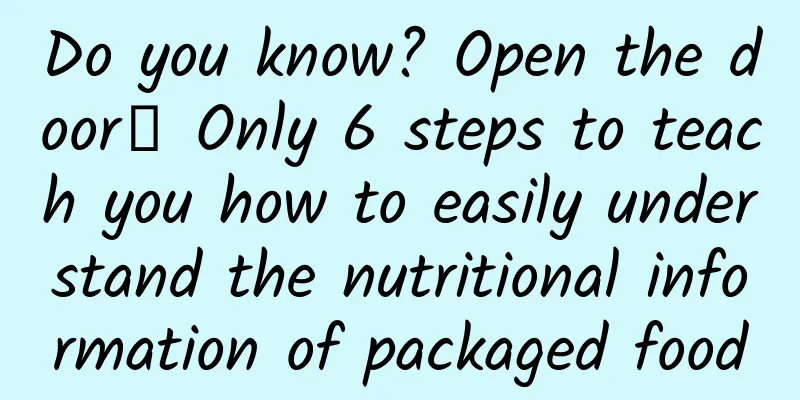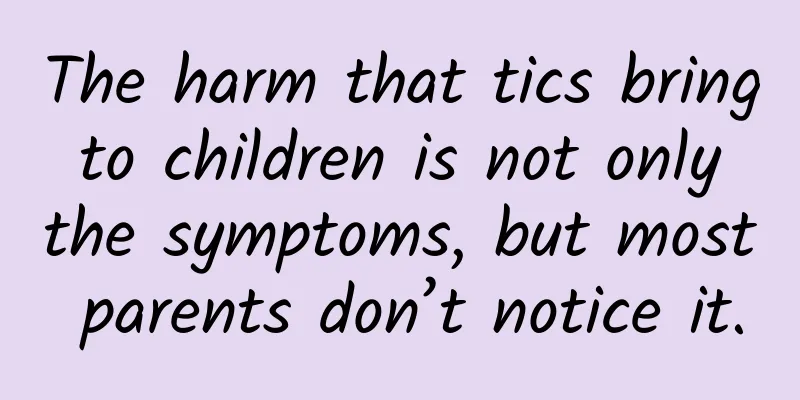Do you know? Open the door┋ Only 6 steps to teach you how to easily understand the nutritional information of packaged food

|
Expert who wrote this article: Li Yue, clinical nutritionist at the First Affiliated Hospital of Xinjiang Medical University and registered nutritionist in China. Review expert: Li Li, President of the Xinjiang Nutrition Society, Director of the Clinical Nutrition Department of the First Affiliated Hospital of Xinjiang Medical University, and Chief Science Communication Expert of the Autonomous Region. The nutritional information table is a must-read when purchasing food. According to the provisions of my country's "General Rules for Nutrition Labeling of Pre-packaged Foods (GB28050-2011)", energy, protein, fat, carbohydrates and sodium are mandatory items to be labeled in my country's nutrition labeling, which can help us quickly understand the nutritional composition and characteristics of food. Simple 6 steps, easy to understand, smart shopping, healthy entry See net content Know the Weight of Whole Foods Look at the calories Look at the calories per 100g/per 100ml/per serving in the ingredient list, and then calculate the calories of the entire food based on the net content. If the unit is KJ, divide it by 4.184 to get kilocalories (kcal). 1 kcal = 4.184 kilojoules (kJ) You can compare it with common foods: 100g apple has 50 calories, 1 100g steamed bun has 200kcal, and 1 bowl of 100g rice has 160kcal. Look at the Nutritional Reference Value (NRV). NRV% is the percentage of nutrients contained in every 100g/every 100ml/each serving of food as a percentage of our daily recommended intake. NRV% is a method for consumers to quickly evaluate the energy and nutrients of food when choosing food. NRV% can also be used to compare foods of the same type from different brands. By checking the NRV%, you can choose foods that are high in protein and low in calories, fat, carbohydrates, and sodium. Generally speaking, NRV%≤5% is low; 10%≤NRV %≤19% is relatively high; and NRV%≥20% is very high. See nutrients to limit Foods containing high trans fatty acids, high saturated fatty acids, high sodium, and high sugar are not good for your health. Eating too much will increase the risk of various chronic diseases. Although they claim to be "sugar-free", they are still high-carbohydrate refined foods, with high fat content and calories. They are also risk factors for chronic diseases such as obesity, diabetes, and fatty liver. Diabetic patients should not eat such foods with confidence. The nutritional ingredient table states "trans fatty acids are 0", but the ingredient list contains hydrogenated or partially hydrogenated vegetable oils, shortening, margarine, artificial cream, non-dairy creamer, refined vegetable oils, refined rapeseed oil, cocoa butter substitutes, hydrogenated rapeseed oil/soybean oil/palm oil and other ingredients. Excessive consumption still poses a risk of exceeding the trans fatty acid standard. See what nutrients you need to get my country's Food Labelling Law stipulates that protein, carbohydrates (dietary fiber) and other beneficial vitamins and minerals must be compulsorily marked on nutrition labels, and nutrition claims such as "high calcium", "high protein", "vitamin D supplement", "vitamin C supplement", "high iron" and "dietary fiber supplement" must be made on food packaging. Especially calcium and vitamin D, which are often lacking in Chinese people, you can choose fortified foods when purchasing food. Look at nutrition The General Rules for Nutrition Labelling of Pre-packaged Foods also stipulate that nutrient function claims can only indicate the effects of a certain nutrient on the normal physiological functions of the body, and may not claim or imply that it has the effect of curing, treating, or preventing diseases. If you see something like "a certain yogurt can cure constipation" on food packaging, it is a false statement and the quality of the food needs to be questioned. All foods that make nutritional function claims should list the corresponding nutrients in the nutrition label. When buying food, read the label and let the nutrition information table be a good helper for you to choose food scientifically. References [1] General Rules for Nutrition Labelling of Prepackaged Foods (GB28050-2011) [2] Chinese Nutrition Society. Dietary Guidelines for Chinese Residents 2022[M]. Beijing: People's Medical Publishing House, 2022 [3] Ministry of Health of the People’s Republic of China. General Principles of Nutrition Labelling for Prepackaged Foods. 2013 |
<<: Open airway for cardiopulmonary resuscitation
>>: Back-to-school eye protection guide: a few simple steps to make your vision clearer
Recommend
What are the ways for pregnant women to prevent stretch marks?
One thing that expectant mothers are very worried...
How many days does it take for my first period to go away?
Every woman has her period every month, and each ...
Qingbitang: Don’t worry about rhinitis in winter, six methods can help you solve it easily!
Rhinitis refers to inflammation of the nasal muco...
What causes back and leg pain during menopause?
It is actually quite common to have back and leg ...
How to clean the fuel injector when it is clogged? How often should the fuel injector be cleaned?
The fuel injector is a very precise device. After...
What is the cause of female breast pain and lumps?
In our lives, we often encounter some things that...
What are the cultural characteristics and natural scenery of Mount Hua? How many meters is it from the bottom of Mount Hua to the top?
Climbing Huashan, you can feel the charm of natur...
Why is the areola itchy and peeling?
Breasts are a special organ of women, which can m...
Diabetics should be prescribed to "walk"! Italian guidelines
Recently, two Italian societies conducted a syste...
What causes premenstrual breast pain?
When many women go to the district gynecological ...
What causes memory loss in women?
When women suffer from memory loss, they should p...
Can I eat oranges during menstruation?
When it comes to menstruation, women all know thi...
Can I spray foliar fertilizer on Christmas cactus? How to plant bare-root Christmas cactus?
Christmas cactus is a common flower in life. Beca...
How to make watermelon juice taste good? How many calories does watermelon juice have?
Watermelon has the functions of quenching thirst,...
Why do women urinate frequently at night?
A normal adult urinates 4 to 6 times during the d...









